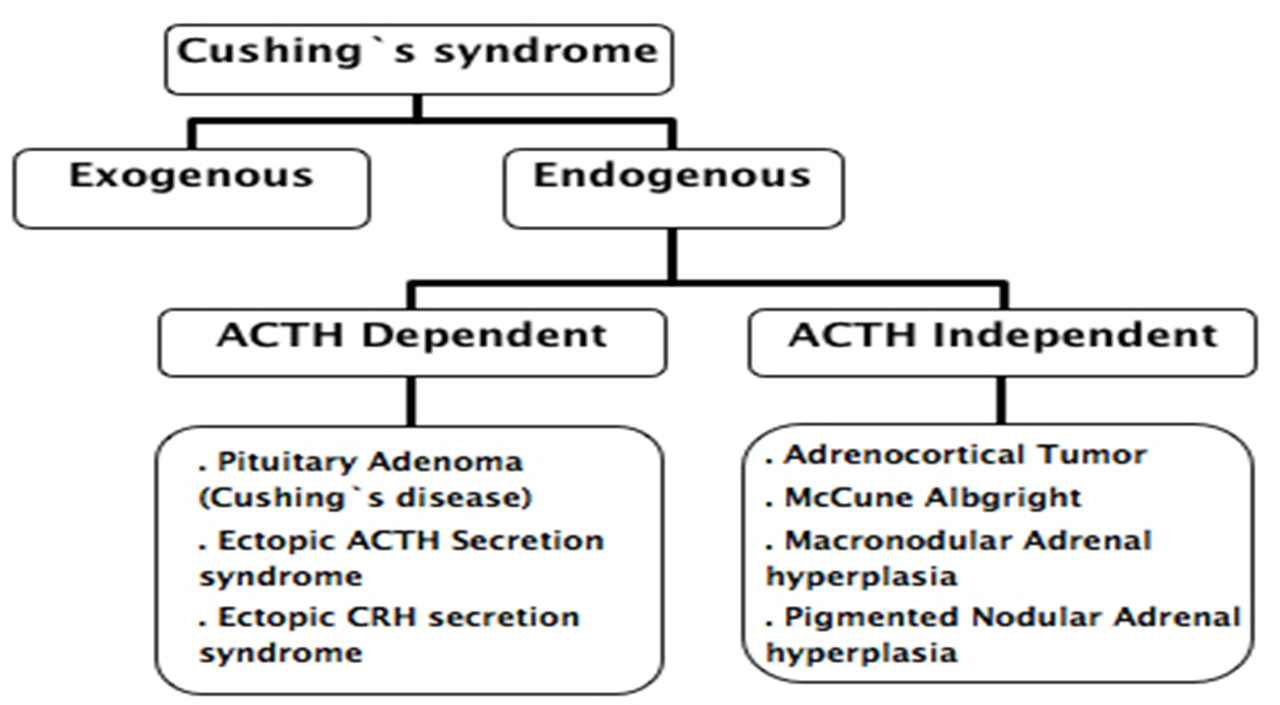Cushing’s syndrome
Cushing’s syndrome is a condition that results from long-term exposure to corticosteroids due to any etiology.
Cushing’s disease
If ACTH excess is the cause of hypercortisolism due to a pituitary gland tumor then, in this case, it is called Cushing’s disease instead of the syndrome.
Signs and symptoms are same in both Cushing’s syndrome and Cushing’s disease, but in Cushing’s disease you may notice some additional signs and symptoms due to pituitary adenoma (tumor), such as, headache, blurring or loss of vision of one or both eyes and sometimes signs and symptoms due to hyper or hyposecretion of other pituitary hormones.
Epidemiology
- Prevalence = 13/100000
- Incidence = 1-2/100000
- 8 times more common in women than men
- Most common in ages 20-40 years
Ectopic ACTH secretion
Cause of ectopic ACTH secretion are;
- Bronchial carcinoid tumor
- Pancreatic Carcinoid tumor
- Thymus Carcinoid Tumor
- Small-cell lung cancer
- Medullary thyroid carcinoma
- Pheochromocytoma (Catecholamines and ACTH)
Adrenal tumor/hyperplasia
- Macronodular adrenal hyperplasia: Low ACTH, but autocrine stimulation of cortisol production.
- Primary Pigmented Nodular Hyperplasia: part of Carney’s complex (autosomal dominant neoplasia associated with Cardiac Myxomas, Hyper lentiginosis, Sertoli Cell tumor and PPNH)
ACTH-Secreting Pituitary Adenoma
Pituitary adenoma secretes increased amount of ACTH, which stimulates cortisol secretion, independent of the negative feedback mechanism.
Clinical features:
A patient of Cushing’s syndrome presents with following signs and symptoms.
- Hirsutism
- Acne plethora
- Moon face
- Peptic ulcers
- Loss of height and back pain from compression fractures due to osteoporosis
- Hyperglycemia
- Menstrual disturbance
- Exuberant callus with fractures
- Prone to infections
- Psychosis
- Cataracts, mild exophthalmos
- Hypertension
- Centripetal obesity
- Striae
- Decreased skin thickness
- Wasting and weakness of proximal thigh muscles
- Bruising
There is a mnemonic which can be used to remember the signs and symptoms of Cushing’s syndrome.
CUSHING
C: Central obesity
U: Urinary cortisol and glucose increase
S: Striae, suppressed immunity
H: Hypercortisolism, hypertension, hyperglycemia, hypercholesterolemia
I: Iatrogenic (Increased administration of corticosteroids)
N: Noniatrogenic (Neoplasms)
G: Glucose intolerance, growth retardation.
| Tests to order | Results if Cushing’s Syndrome/disease |
| 24 hours urinary free cortisol in three separate collections | Increased free cortisol |
| Overnight exposure to dexamethasone, and check cortisol level at 8 AM in the morning | Failure of suppression of morning cortisol |
| Check cortisol at midnight | Loss of diurnal rhythm, high levels at midnight, the time of physiological lowest secretion. |
| ACTH | Low in case of Cushing syndrome, High in case of Cushing’s disease or ectopic ACTH secretion. |
| CT Adrenal | Evidence of Adrenal tumor |
| MRI brain (pituitary) | Evidence of Pituitary adenoma |
| Inferior petrosal sinus sampling | High level of ACTH in case of Cushing disease |
How to differentiate between Cushing disease (pituitary dependent) and Cushing syndrome 2nd to Ectopic ACTH secretion?
- Do MRI Pituitary and look for the evidence of pituitary adenoma and get inferior petrosal sinus sample for level of ACTH, If there is pituitary adenoma with increased level of ACTH in inferior petrosal sinus sample as compared to peripheral blood sample (>2:1) or after CRH injection the level of ACTH in the inferior sample becomes > 3 within 2 – 5 minutes then it means the affected patient is suffering from Cushing’s disease.
- If the above tests are negative then, do the extensive workup and find the source of ectopic ACTH secretion as we have discussed the causes of ectopic ACTH secretion above.
Treatment of Cushing’s
Treatment is simple, eradicate the cause.
Surgery is the definitive treatment, if
- there is an adrenal tumor, surgical removal of tumor cures the syndrome.
- If there is an ACTH-secreting pituitary adenoma, then transsphenoidal surgical resection of the pituitary is the treat of choice.
If even after the pituitary surgery hypercortisolism is still found to present, then pituitary irradiation is the next step, you may also give a trial of the drugs (discussed below) to achieve the biochemical cure, also do serial MRI evaluation and try to find the ectopic ACTH source, if negative, continue medical management with the help of drugs and plan bilateral adrenalectomy.
Drugs used to treat Cushing’s syndrome
- Pasireotide:- Somatostatin analog – lowered plasma ACTH levels and cortisol.
- Ketoconazole:- An imidazole derivative inhibits P450enzymes and lowers cortisol levels
- Mefepristone:- a glucocorticoid receptor antagonist, blocks cortisol peripheral action- approved to treat hyperglycemia in Cushing’s disease
- Metyrapone:- inhibits 11beta-hydroxylase activity and normalizes cortisol levels
Author:
Dr. Adil Ramzan
MBBS, MD Internal Medicine Resident. Pakistan Institute of Medical Sciences, Shaheed Zulfiqar Ali Bhutto Medical University, Islamabad Pakistan.

